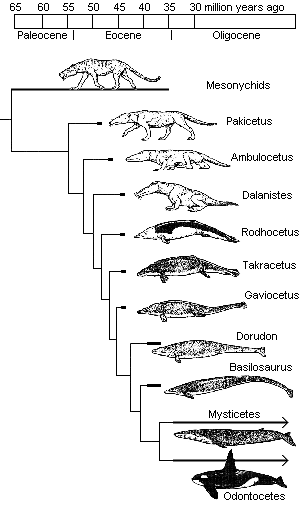jlay wrote:bippy123 wrote:Ivellious wrote:Wow, KBC, congrats on taking what I said and not even remotely interpreting it correctly. I said populations change...never did I say that a million individuals are spontaneously changed at once. I meant exactly what you said...allele frequencies in a population change over time due to various genetic and environmental interplay.
I was simply correcting the statement that skakos made about animals constantly needing to change, because that seemed to imply that individual animals "evolve." I said that populations evolve over time, which is absolutely correct.
But remember Ivellious that there seem to be limits to this change, and the fossil records show this. We have no empirical evidence that macroevolution occurs. Zilch, zippity doo-daa, as was shown recently by the crashing down of the whale evolutionary chart which has been turned on its head.
You don't even need fossil records. You can see a lot through selective breeding. Take canines for example. You can pressure the genetic info into a lot of diversity but it has limits. I'd love to see an explanation of how nature goes from invertebrates to vertebrates.
Thats the other problem Jlay, and dont forget the fruit fly experiments where they subjected them to blasts of radiation and every harsh conditions but not only did they produce nothing but fruit flies.
http://www.apologeticspress.org/APConte ... ticle=2501
Enter Drosophila melanogaster, also known as the common fruit fly. Drosophila maintains several characteristics that make it the perfect specimen for laboratory mutation experiments. First, the female fly is extremely fertile. She can potentially lay 100 eggs a day, up to 2,000 eggs in her life (Reeve and Black, 2001, p. 157). Second, Drosophila grows from an egg to an adult in 10-12 days, thus producing up to 30 generations per year (p. 157). Due to these and other ideal traits, since 1901 the fruit fly has been one of, if not the, most often used organisms in genetic mutation experiments. Reeve and Black noted: “The exploitation that made Drosophila the most important organism for genetical research was its selection by the embryologist Thomas Hunt Morgan for his studies of mutation...” (p. 157).
Since the early 1900s, multiplied millions of fruit fly generations have been bred in laboratories across the globe. Scientists performing these experiments have introduced fruit flies to various levels of radiation and countless other factors designed to produce mutations. Sherwin noted that over 3,000 different mutations have been documented in the fruit fly gene pool (n.d.). These mutations have caused such physical characteristics as eyeless flies, flies with different colored eyes, flies with legs growing from their heads, extra pairs of wings, various colored bodies, wingless flies, flies with unusually large wings, flies with useless wings, flies with twisted wings, etc. The list could go on for hundreds of pages.
So extensive have fruit fly experiments been, that the massive numbers of generations produced, and the mutations created, would be the equivalent of millions of years of supposed evolutionary time. Furthermore, intelligent scientists have acted as the “selecting agent,” thus speeding up the accumulation of “beneficial” mutations. If evolution by genetic mutation and natural selection really can take place, we should discover that the fruit fly has mutated into several new kinds of animals that branch out from their “flyhood” into other types of organisms. We should see creatures that are part fly and part something else.
What do we see? Fruit flies. That is all we see. After a hundred years of experimentation, thousands of lab-induced mutations in multiplied millions of flies, and intelligent selection acting on those mutations, the world’s most brilliant minds have not been able to produce any different kinds of creatures from Drosophila. Concerning the fruit fly stasis, late evolutionist Pierre Grassé stated: “The fruitfly (Drosophila melanogaster), the favorite pet insect of the geneticists, whose geographical, biotopical, urban, and rural genotypes are now known inside out, seems not to have changed since the remotest times (as quoted in Sherwin, n.d.). Norman Macbeth highlighted the late evolutionist Richard Goldschmidt’s thoughts about the fruit fly: “After observing mutations in fruit flies for many years, Goldschmidt fell into despair. The changes, he lamented, were so hopelessly micro that if a thousand mutations were combined in one specimen, there would still be no new species” (1971, p. 33). The bottom line of all experiments ever done on fruit flies is that they stay fruit flies.
The results of such experimentation “fly” in the face of evolution, but they are exactly what one would expect to find if the biblical story of Creation is true. In Genesis 1, the Bible states that God made all the flying creatures and land animals on days five and six of the Creation week. In the creation model, the Bible specifically states that all organisms were to multiply according to their own kinds (Genesis 1:11,21,24,25). Thus, one would expect fruit flies, regardless of the number of mutations introduced and selected, to be bound to reproduce only after their “own kind”—which is exactly what the last 100 years of fruit fly research has shown. It is amazing how menacingly a little fruit fly can bug those who adhere to evolution.
REFERENCES
MacBeth, Norman (1971), Darwin Retried (Boston, MA: Gambit).
Reeve, E.C. and Isobel Black, ed. (2001), Encyclopedia of Genetics, [On-line], URL:
http://books.google.com/books?id=JjLWYK ... PA157&lpg= PA157&dq=Drosophila+Fruit+fly+mutations&source=web&ots= V5yPPBPE6h&sig=fOkUS_qLsARelWNDqpe5uhq70mI&hl=en.
Sherwin, Frank (no date), “Fruit Flies in the Face of Macroevolution,” [On-line], URL:
http://www.icr.org/article/2602/.
